Exe-8B and 8C Current Electricity ICSE Class-10 Concise Physics Selina Solutionss Chapter-8 . We Provide Step by Step Answer of Exercise-8(A), MCQs-8(A), Numericals-8(A), Exercise-8(B), MCQ-8(B), Numericals-8(B) Exercise-8(C), MCQ-8(C) and Numericals -8(C) Questions of Exercise-8 Current Electricity ICSE Class-10. Visit official Website CISCE for detail information about ICSE Board Class-10.
| Board | ICSE |
| Publications | Selina Publication |
| Subject | Physics |
| Class | 10th |
| Chapter-8 | Current Electricity (Exe-8B and 8C) |
| Book Name | Concise |
| Topics | Solution of Exercise-8(A), MCQs-8(A), Numericals-8(A),, Exercise-8(B), MCQ-8(B), Numericals-8(B) Exercise-8(C), MCQ-8(C) and Numericals -8(C) |
| Academic Session | 2021-2022 |
Exe-8B and 8C Current Electricity ICSE Class-10 Concise Physics Selina Solutionss Chapter-8
-: Select Exercise :-
Exercise-8(A), MCQs-8(A), Numericals-8(A),
Exe-8(B), MCQ-8(B), Num-8(B) Exe-8(C), MCQ-8(C) and Num-8(C)
How to Solve Numericals of Current Electricity ICSE Class-10
Current Electricity deals with ohm’s law, concepts of E.M.F., Potential Difference, resistance, resistances in series and parallel; internal resistance also deals in Current Electricity. Concepts of P.D. Current Electricity in Physics of Chapter 8 and resistance and charge. Simple Numerical Problems using the above relations in Current Electricity.
Excercise 8 (B) ICSE Class-10 Selina Solutions Physics Current Electricity
Page 200
Question 1
Explain the meaning of the terms e.m.f., terminal voltage and internal resistance of cell.
Answer 1
e.m.f.: When no current is drawn from a cell, the potential difference between the terminals of the cell is called its electro-motive force (or e.m.f.).
Terminal voltage: When current is drawn from a cell, the potential difference between the electrodes of the cell is called its terminal voltage.
Internal Resistance: The resistance offered by the electrolyte inside the cell to the flow of electric current through it is called the internal resistance of the cell.
Question 2
State two differences between the e.m.f. and terminal voltage of a cell.
Answer 2
| e.m.f. of cell | Terminal voltage of cell |
| 1.It is measured by the amount of work done in moving a unit positive charge in the complete circuit inside and outside the cell. | 1. It is measured by the amount of work done in moving a unit positive charge in the circuit outside the cell. |
| 2.It is the characteristic of the cell i.e., it does not depend on the amount of current drawn from the cell | 2. It depends on the amount of current drawn from the cell. More the current is drawn from the cell, less is the terminal voltage. |
| 3.It is equal to the terminal voltage when cell is not in use, while greater than the terminal voltage when cell is in use. | 3. It is equal to the emf of cell when cell is not in use, while less than the emf when cell is in use. |
Question 3 (Exe-8B and 8C Current Electricity ICSE )
Name two factors on which the internal resistance of a cell depends and state how does it depend on the factors stated by you.
Answer 3
Internal resistance of a cell depends upon the following factors:
(i) The surface area of the electrodes: Larger the surface area of the electrodes, less is the internal resistance.
(ii) The distance between the electrodes: More the distance between the electrodes, greater is the internal resistance.
Question 4
A cell of emf ε and internal resistance r is used to send current to an external resistance R. Write expressions for (a) the total resistance of the circuit (b) the current drawn from the cell and (c) the p.d. across the cell (d) voltage drop inside the cell.
Answer 4
(a) Total resistance = R + r
(b) Current drawn from the circuit :
As we know that,
=V+v
= IR + Ir
=I(R+r)
I = e / (R + r)
(c) p.d. across the cell :
(d) voltage drop inside the cell:
Question 5
A cell is used to send current to an external circuit.
(a) How does the voltage across its terminal compare with its emf?
(b) Under what condition is the emf of a cell equal to its terminal voltage?
Answer 5
(a) Terminal voltage is less than the emf : Terminal Voltage < e.m.f.
(b) e.m.f. is equal to the terminal voltage when no current is drawn.
Question 6
Explain why the p.d. across the terminals of a cell is more in an open circuit and reduced in a closed circuit.
Answer 6
When the electric cell is in a closed circuit the current flows through the circuit. There is a fall of potential across the internal resistance of the cell. So, the p.d. across the terminals in a closed circuit is less than the p.d. across the terminals in an open circuit by an amount equal to the potential drop across the internal resistance of the cell.
Question 7 (Exe-8B and 8C Current Electricity ICSE )
Write the expressions for the equivalent resistance R of three resistors R1, R2 and R3 joined in (a) parallel, (b) series.
Answer 7
(a) Total Resistance in series:
(b) Total Resistance in parallel:
Question 8
How would you connect two resistors in series? Draw a diagram. Calculate the total equivalent resistance.
Answer 8
If current I is drawn from the battery, the current through eac resistor will also be I.
On applying Ohm’s law to the two resistors separately, we further
have
V1 = I R1
V2 = I R2
V=V1 + V2
IR = I R1+ I R2
R= R1+ R2
Total Resistance in series R :
Question 9
Show by a diagram how two resistors R1 and R2 are joined in parallel. Obtain an expression for the total resistance of the combination.
Answer 9
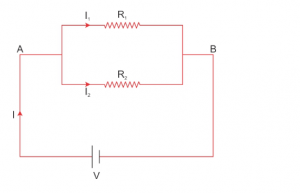
On applying Ohm’s law to the two resistors separately, we further
Have
I1 = V / R1
I2 = V / R2
I = I1 + I2
Question 10
State how are the two resistors are joined with a battery in each of the following cases when:
(a) same current flows in each resistor
(b) potential difference is same across each resistor.
(c) equivalent resistance is less than either of the two resistances.
(d) equivalent resistance is more than either of the two resistances.
Answer 10
(a) series
(b) parallel
(c) parallel
(d) series
Question 11 (Exe-8B and 8C Current Electricity ICSE )
The V-I graph for a series combination and for a parallel combination of two resistors is shown in fig. Which of the two, A or B, represents the parallel combination? Give a reason for your answer.
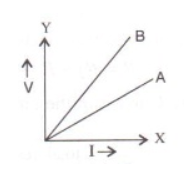
Answer 11
For the same change in I, change in V is less for the straight line A than for the straight line B (i.e., the straight line A is less steeper than B), so the straight line A represents small resistance, while the straight line B represents more resistance. In parallel combination, the resistance decreases while in series combination, the resistance increases. So A represents the parallel combination.
MULTIPLE CHOICE TYPE – 8 (B) Selina Solutions Physics Current Electricity
Page 200
Question 1
In series combination of resistances:
(a) p.d is same across each resistance
(b) total resistance is reduced
(c) current is same in each resistance
(d) all above are true
Answer 1
(c) In series combination of resistances, current is same in each resistance.
Question 2
In parallel combination of resistances:
(a) p.d is same across each resistance
(b) total resistance is increased
(c) current is same in each resistance
(d) all above are true
Answer 2
(a) In parallel combination of resistances, P.D. is same across each resistance.
Question 3
Which of the following combinations have the same equivalent resistance between X and Y?
Answer 3
(a) and (d)
NUMERICALS – 8 (B) Current Electricity Concise Physics Solution
Page 201
Question 1
The diagram in Fig. 8.42 shows a cell of e.m.f. ε = 2 volt and internal resistance r = 1 ohm to an external resistance R = 4 ohm. The ammeter A measures the current in the circuit and the voltmeter V measures the terminal voltage across the cell. What will be the readings of the ammeter and voltmeter when (i) the key K is open, (ii) the key K is closed.
Answer 1
(i) Ammeter reading = 0 because of no current
Voltage V = ϵ − Ir
V = 2 − 0 × 1 = 2 volt
(ii) Ammeter reading :
I =ε /(R + r)
I=2 / (4+1) = 2 / 5 = 0.4 amp
Voltage reading :
Voltage V = ϵ – Ir
V=2 – 0.4 x 1 = 2 – 0.4 = 1.6 V
Question 2
A battery of e.m.f 3.0 V supplies current through a circuit in which the resistance can be changed. A high resistance voltmeter is connected across the battery. When the current is 1.5 A, the voltmeter reads 2.7 V. Find the internal resistance of the battery.
Answer 2
ε = 3 volt
I = 1.5 A
V = 2.7 V
V = ε − Ir
r = (e-V) / I
= (3 – 2.7) / 1.5 = 0.2 ohm
Question 3
A cell of emf 1.8 V and internal resistance 2 ohm is connected in series with an ammeter of resistance 0.7 ohm and resistance of 4.5 ohm as shown in figure.

(a) What would be the reading of the ammeter?
(b) What is the potential difference across the terminals of the cell?
Answer 3
(a) ε = 1.8 V
Total Resistance = 2 + 4.5 + 0.7 = 7.2 W
I=?
I= / R (total resistance)
I = 1.8 / 7.2 = 0.25 A
(b) Current (calculated in (a) part) I = 0.25 A
Now, total resistance excluding internal resistance = 4.5 + 0.7 = 5.2 ohm
V = IR = 0.25 x 5.2 = 1.3 V
Question 4
The music system draws a current of 400mA when connected to a 12V battery.
(i) What is the resistance of the music system
(ii) The music system if left playing for several hours and finally the battery voltage drops and the music systems stops playing when the current drops to 320mA. At what battery voltage does the music system stop playing?
Answer 4
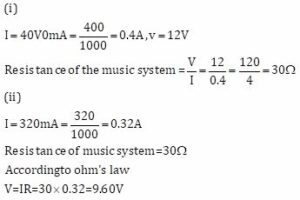
Question 5
A Cell of e.m.f. ε and internal resistance ? sends current 1.0 A when it is connected to an external resistance 1.9Ω. But it sends current 0.5 A when it is connected to an external resistance 3.9 Ω.Calculate the values of ε and ?.
Answer 5
In first case
I = 1 A, R = 1.9 ohm
ε = I(R + r) = 1(1.9+r)
ε = 1.9 + r————(1)
In second case
I = 0.5 A, R = 3.9 ohm
ε = I(R + r) = 0.5 (3.9 + r)
ε = 1.95 + 0.5r —————-(2)
From eq. (1) and (2),
1.9 + r = 1.95 + 0.5r
r = 0.05/0.5 = 0.1 ohm
Substituting value of r
ε = 1.9 + r = 1.9 + 0.1 = 2 V
Question 6 (Exe-8B and 8C Current Electricity ICSE )
Two resistors having resistance 4Ω and 6Ω are connected in parallel. Find their equivalent resistance.
Answer 6
Let ‘ R be their equivalent resistance of the 4Ω and 6Ω resistors connected in parallel
Then,
1R=14+16=3+212=512Ω
Or,
R=125 = 2.4Ω
Question 7
Four resistors each of resistance 2Ω are connected in parallel. What is the effective resistance?
Answer 7
R1 = 2 ohm
R2 = 2 ohm
R3 = 2 ohm
R4 = 2 ohm
1R=1R1+1R2+1R3+1R4
=
12+12+12+12=2
R = 0.5 ohm
Question 8
You have three resistors of values 2Ω, 3Ω and 5Ω. How will you join them so that the total resistance is less than 1Ω? Draw diagram and find the total resistance.
Answer 8
The three resistors should be connected in parallel.
To get a total resistance less than 1Ω

Let ‘ R be the total resistance.
Then,
1R=12+13+15=15+10+1630=3130Or,
R=3031=0.97Ω
Question 9
Three resistors each of 2Ω are connected together so that their total resistance is 3Ω. Draw a diagram to show this arrangement and check it by calculation.
Answer 9
R1 = 2 ohm
R2 = 2 ohm
R3 = 2 ohm
1/R=1R1+1R2
IR=12+12=1
R=R+R3=1+2=3ohm
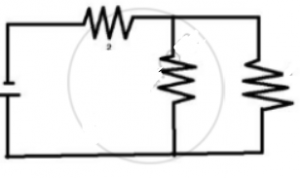
Question 10 (Exe-8B and 8C Current Electricity ICSE )
Calculate the equivalent resistance between the points A and B in Fig. 8.44 if each resistance is 2.0Ω.
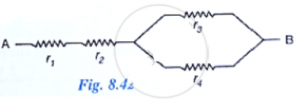
Answer 10
A combination consists of three resistors in series. Four similar sets are connected in parallel. If the resistance of each resistor is 2 ohm, find the resistance of the combination.
Question 11
A combination consists of three resistors in series. Four similar sets are connected in parallel. If the resistance of each resistor is 2 ohm, find the resistance of the combination.
Answer 11
Resistance of each set:
1r = 2 + 2 + 2 = 6 ohm
2r = 2 + 2 + 2 = 6 ohm
3r = 2 + 2 + 2 = 6 ohm
4r = 2 + 2 + 2 = 6 ohm
Now these resistances are arranged in parallel :
1/r=1r1+1r2+1r3+1r4
Question 12
In the circuit shown below in Fig 8.43, calculate the value of x if the equivalent resistance between A and B is 4Ω.
Answer 12
r1=4ohm
r2=8ohm
r3=xohm
r4=5ohm
r = 4 ohm
r=r_1+r_2=4+8=12 ohm
r=r_3+r_4=(x+5) ohm
1r=1r+1r
14=112+15+x
16=15+xx=1 ohm
Question 13
Calculate the effective resistance between the points A and B in the circuit shown in Figure. 8.46.
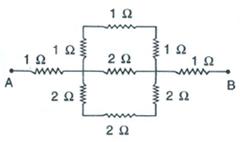
Answer 13
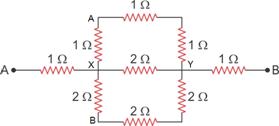

Page 202
Question 14
A uniform wire with a resistance of 27 ohm is divided into three equal pieces and then they are joined in parallel. Find the equivalent resistance of the parallel combination.
Answer 14
Wire cut into three pieces means new resistance = 27/3 = 9
Now three resistance connected in parallel :

Question 15
A circuit consists of a 1 ohm resistor in series with a parallel arrangement of 6 ohm and 3 ohm resistors. Calculate the total resistance of the circuit. Draw a diagram of the arrangement.
Answer 15


Question 16 (Exe-8B and 8C Current Electricity ICSE )
Calculate the effective resistance between the points A and B in the network shown below in figure.

Answer 16
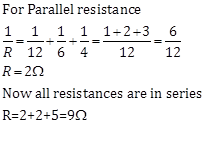
Question 17
Calculate the equivalent resistance between the points A and B in the adjacent diagram in the figure.
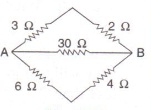
Answer 17
R1=3+2 = 5 ohm
R2=30 W
R3=6+4 = 10 ohm
R1 , R2 and R3 are connected in parallel

Question 18
In the network shown in adjacent figure 8.49, calculate the equivalent resistance between the points (a) A and B, and (b) A and C
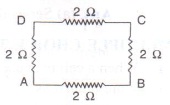
Answer 18
(a) R1=2+2+2 = 6ohm
R2=2ohm
R1 and R2 are connected in parallel

(b) R1=2+2 = 4 ohm
R2=2+2=4 W
R1 and R2 are connected in parallel

Question 19
Five resistors, each 3 ohm, are connected as shown in figure 8.50. Calculate the resistance (a) between points P and Q (b) between points X and Y.
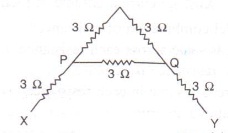
Answer 19
(a) R1=3+3=6 W
R2=3 W
R1 and R2 are connected in parallel

(b) As calculated above R=2 ohm
R3 = 3 ohm
R4 = 3 ohm
R’=R+R3+R4=2+3+3 = 8 ohm
Question 20 (Exe-8B and 8C Current Electricity ICSE )
Two resistors of 2.0 ohm and 3.0 ohm are connected (a) in series, (b) in parallel, with a battery of 6.0 V and negligible internal resistance. For each case draw a circuit diagram and calculate the current through battery.
Answer 20
(a)

R1=2 ohm
R2=3 ohm
R = R1 + R2 = 2 + 3 = 5 ohm
V=6 V
![]()
(b)
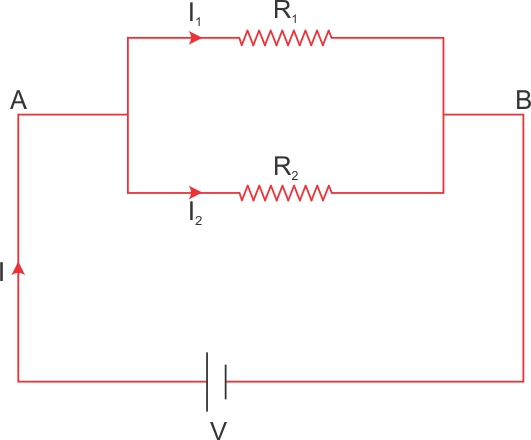
R1 and R2 are connected in parallel

Question 21
A resistor of 6 ohm is connected in series with another resistor of 4 ohm. A potential difference of 20 V is applied across the combination. (a) Calculate the current in the circuit and (b) potential difference across the 6 ohm resistor.
Answer 21
(a) R1=6 ohm
R2=4 ohm
R = R1 + R2 = 6 + 4 = 10 ohm
V=20 V
I=V/R = 20/10 = 2 A
(b) R = 6 W
I = 2 A
V = ?
V = IR = 6 x 2 = 12 V
Question 22
Two resistors of resistance 4 Ω and 6 Ω are connected in parallel to a cell to draw 0.5 A current from the cell.
(a) Draw a labeled diagram of the arrangement
(b) Calculate current in each resistor.
Answer 22
(a) Circuit diagram

(b) Equivalent resistance of the circuit:

Hence, the emf of the cell is

Therefore, current through each resistor is

Question 23
Calculate current flowing through each of the resistors A and B in the circuit shown in figure 8.51?

Answer 23
For resistor A :
R=1 ohm
V=2 V
I=V/R = 2/1 = 2 A
For resistor B :
R = 2 ohm
V = 2 V
I=V/R = 2/2 = 1 A
Question 24
In figure 8.52, calculate :
(a) the total resistance of the circuit.
(b) the value of R, and
(c) the current flowing in R
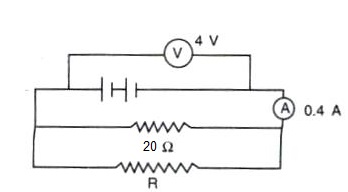
Answer 24
(a)
V=4 V
I=0.4 A
Total Resistance R’=?
R’ = V/I = 0.4/4 = 10 ohm
(b)
R1= 20 ohm
R’ = 10 ohm

(c)
R=20 ohm
V=4 V
I=V/R = 4/20 = 0.2 A
Question 25 (Exe-8B and 8C Current Electricity ICSE )
A particular resistance wire has a resistance of 3 ohm per meter. Find :
(a) The total resistance of three lengths of this wire each 1.5 m long, in parallel.
(b) The potential difference of the battery which gives a current of 2 A in each of the 1.5 m length when connected in the parallel to the battery (assume that resistance of the battery is negligible).
(c) The resistance of 5 m length of a wire of the same material, but with twice the area of cross section.
Answer 25
(a) Resistance of 1m of wire = 3 ohm
Resistance of 1.5 m of wire = 3 x 1.5 = 4.5 W
(b) I=2 A
V=IR = 2 x 4.5 = 9 V
(c) R=3 ohm for 1 m
For 5 m : R=3 x 5 = 15 ohm
But Area A is double i.e. 2 A and Resistance is inversely proportional to area so Resistance will be half.
R=15/2 = 7.5 ohm
Page 203
Question 26
A cell supplies a current of 1.2 A through two 2 ohm resistors connected in parallel. When resistors are connected in series, it supplies a current of 0.4 A. Calculate: (i) the internal resistance and (ii) e.m.f. of the cell.
Answer 26
In parallel R = ½ + ½ = 1 ohm
I = 1.2 A
![]() =I(R+r) = 1.2(1+r)= 1.2 + 1.2 r
=I(R+r) = 1.2(1+r)= 1.2 + 1.2 r
In series R = 2+2=4 ohm
I=0.4 A
=I(R+r) = 0.4(4+r) = 1.6 + 0.4 r
It means :
1.2 + 1.2 r = 1.6 + 0.4 r
0.8 r = 0.4
r = 0.4 / 0.8 = ½ = 0.5 ohm
(i) Internal resistance r = 0.5 ohm
(ii) =I(R+r) = 1.2(1+0.5) = 1.8 V
Question 27
A battery of emf 15 V and internal resistance 3 ohm is connected to two resistors 3 ohm and 6 ohm connected in parallel. Find (a) the current through the battery (b) p.d. between the terminals of the battery (c) the current in 3 ohm resistor (d) the current in 6 ohm resistor.
Answer 27
(a)In parallel 1/R = 1/3 + 1/6 = 1/2
So R = 2 ohm
r = 3 W
=15 V
=I(R+r)
15=I(2+3)
I=15/5 = 3 A
(b)V=?
R=2 ohm
V=IR = 3 x 2 = 6 V
(c)V=6 V
R = 3 ohm
I=V/R = 6/3 = 2 A
(d) R=6 ohm
V= 6 V
I=V/R = 6/6 = 1 A
Question 28
The circuit diagram in Fig. 8.53 shows three resistors 2 Ω, 4 Ω and R Ω connected to a battery of e.m.f. 2 V and internal resistance 3 ohm . If main current of 0.25 A flows through the circuit, Find :
(a) the p.d. across the 4 ohm resistor?
(b) the p.d. across the internal resistance of the cell,
(c) the p.d. across the R ohm or 2 ohm resistor, and
(d) the value of R.
Answer 28
(a)R = 4
I = 0.25 A
V=IR = 0.25 x 4 = 1 V
(b)Internal Resistance r=3 ohm
I = 0.25 A
V=IR = 0.25 x 3 = 0.75 V
(c) Effective resistance of parallel combination of two 2 ohm resistances = 1 ohm
V= I/R = 0.25/1 = 0.25 V
(d) I=0.25 A
=2 V, r = 3 ohm
=I(R’+r)
2=0.25(R’+3)
R’=5 W

Question 29 (Exe-8B and 8C Current Electricity ICSE )
Three resistors of 6.0 ohm, 2.0 ohm and 4.0 ohm are joined to ammeter A and a cell of emf 6.0 V as shown in figure. Calculate :
(a) the effective resistance of the circuit.
(b) the reading of ammeter
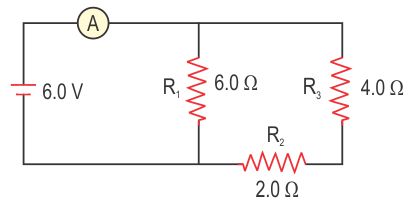
Answer 29
(a) R1=6 W
R’=R2+R3=2+4=6 W
R1 and R’ in parallel :

(b) R= 3 ohm
V=6 V
I=?
I=V/R=6/3=2 A
Question 30
The diagram below in Fig. 8.55 shows the arrangement of five different resistances connected to a battery of e.m.f. 1.8 V. Calculate :
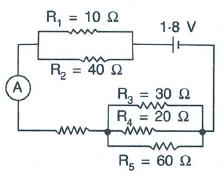
(a) The total resistance of the circuit, and
(b) The reading of ammeter A.
Answer 30
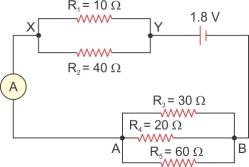

Question 31
A cell of e.m.f. 2 V and internal resistance 1.2 Ω is connected to an ammeter of resistance 0.8 Ω and two resistors of 4.5 Ω and 9 Ω as shown in fig.

Find:
(a) The reading of the ammeter,
(b) The potential difference across the terminals of the cells, and
(c) The potential difference across the 4.5 Ω resistor.
Answer 31
The total resistance of the circuit is

(a) Therefore, the current through the ammeter is
![]()
(b) The potential difference across the ends of the cells is

(c) The potential difference across the 4.5Ωresistor is

Chapter -8, “Current Electricity” Selina Physics Solution Excercise – 8 (C)
Page 211
Question 1
Write an expression for the electrical energy spent in flow of current through an electrical appliance in terms of current, resistance and time.
Answer 1
![]()
Question 2
Write an expression for the electrical power spent in flow of current through a conductor in terms of (a) resistance and potential difference, (b) current and resistance.
Answer 2

Question 3 (Exe-8B and 8C Current Electricity ICSE )
Electrical power P is given by the expression P= (Q x V)/time
(a)What do the symbols Q and V represent?
(b)Express the power P in terms of current and resistance explaining the meanings of symbols used there in.
Answer 3
(a) Q represents Charge and V represents Voltage.
(b) 
Question 4
Name the S.I. unit of electrical energy. How is it related to Wh ?
Answer 4
The S.I. unit of electrical energy is joule.
1 Wh = 3600 J
Question 5
Explain the meaning of the statement ‘the power of an appliance is 100 W’.
Answer 5
The power of an appliance is 100 W. It means that 100 J of electrical energy is consumed by the appliance in 1 second
Question 6
State the S.I. units of electrical power.
Answer 6
The S.I. unit of electrical power is Watt.
Page 212
Question 7
(i)State and define the household unit of electricity.
(ii)What is the voltage of the electricity that is generally supplied to a house?
(iii) What is consumed while using different electrical appliances, for which electricity bills are paid?
Answer 7
(i)The household unit of electricity is kilowatt-hour (kWh).
One kilowatt-hour (kWh) is the electrical energy consumed by an electrical appliance of power 1 kW when it is used for one hour.
(ii)The voltage of the electricity that is generally supplied to a house is 220 Volt.
(iii) electrical energy is consumed.
Question 8
Name the physical quantity which is measured in
(i) kW, (ii) kWh. (iii) Wh
Answer 8
(i)Electrical power is measured in kW and
(ii)Electrical energy is measured in kWh.
(iii)Energy consume is measured in Wh.
Question 9
Define the term kilowatt – hour and state its value in S.I. unit.
Answer 9
One kilowatt-hour (kWh) is the electrical energy consumed by an electrical appliance of power 1 kW when it is used for one hour.
Its value in SI unit is ![]()
Question 10
How do kilowatt and kilowatt-hour differ ?
Answer 10
Kilowatt is the unit of electrical power whereas kilowatt-hour is the unit of electrical energy.
Question 11 (Exe-8B and 8C Current Electricity ICSE )
Complete the following:
(a)……………………..
(b)……………………..
1 kWh= ________ J
Answer 11
(a)![]()
(b) 3.6 x 106 J
Question 12
What do you mean by power rating of an electrical appliance? How do you use it to calculate (a) the resistance of the appliance and (b) the safe limit of the current in it, while in use?
Answer 12
An electrical appliance such as electric bulb, geyser etc. is rated with power (P) and voltage (V) which is known as its power rating. For example: If an electric bulb is rated as 50W-220V, it means that when the bulb is lighted on a 220 V supply, it consumes 50 W electrical power.
(a) To calculate the resistance of the appliance, the expression is:
![]()
(b) The safe limit of current I is: ![]()
Question 13
An electric bulb is marked ‘100 W, 250 V’. What information does this convey?
Answer 13
It means that if the bulb is lighted on a 250 V supply, it consumes 100 W electrical power (which means 100 J of electrical energy is converted in the filament of bulb into the light and heat energy in 1 second).
Question 14
List the names of three electrical gadgets used in your house. Write their power, voltage rating and approximate time for which each one is used in a day. Hence find the electrical energy consumed by each in day in a month of 30 days.
Answer 14
| Appliance | Power
(in Watt) |
Voltage
(in Volts) |
Time
(hours) |
Electrical energy
(E=Pxt) |
| Fluorescent tube | 40 | 220 | 12 x 30 = 360hrs | 14.4kwh |
| Television set | 120 | 220 | 4 x 30 = 120hrs | 14.4kwh |
| Refrigerator | 150 | 220 | 24 x 30 = 720hrs | 108kwh |
Question 15
Two lamps, one rated 220 V, 50 W and the other rated 220 V, 100 W, are connected in series with mains of 220 V. Explain why does the 50 W lamp consume more power.
Answer 15

Question 16 (Exe-8B and 8C Current Electricity ICSE )
Name the factors on which the heat produced in a wire depends when current is passed in it, and state how does it depend on the factors stated by you.
Answer 16
When current is passed in a wire, the heat produced in it depends on the three factors:
(i) on the amount of current passing through the wire,
(ii) on the resistance of wire and (iii) on the time for which current is passed in the wire.
(iii)Dependence of heat produced on the current in wire: The amount of heat H produced in the wire is directly proportional to the square of current I passing through the wire.
(iv)Dependence of heat produced on the resistance of wire: The amount of heat H produced in the wire is directly proportional to the resistance R of the wire.
(v)Dependence of heat produced on the time: The amount of heat H produced in the wire is directly proportional to the time t for which current is passed in the wire.
Chapter :- 8, “Current Electricity” Selina Physics Solution MULTIPLE CHOICE TYPE – 8 (C)
Page 212
Question 1.
When a current I flows through a resistance R for time t, the electrical energy spent is:
(a) IRt
(b) I²Rt
(c) IR²t
(d) I²R/t
Answer 1
(b) I²Rt
Question 2
An electrical appliances has a rating 100 W, 120 V. The resistance of element of appliance when in use is:
(a) 1.2 ohm
(b) 144 ohm
(c) 120 ohm
(d) 100 ohm
Answer 2
(b) 144 ohm
NUMERICALS – 8 (C) Chapter :- 8, “Current Electricity” Selina Physics Solution
Page 212
Question 1
An electric bulb of resistance 500 ohm draws current 0.4 A from the source. Calculate: (a) the power of bulb and (b) the potential difference at its end.
Answer 1
Resistance of electric bulb (R) = 500Ω
Current drawn from the source (I) = 0.4 A
Power of the bulb (P) = VI
V = I x R
V = 0.4 x 500 = 200 V
The potential difference at its end is 200 V.
Hence,
Power (P) = VI
P = 200 x 0.4 = 80 W
The power of the bulb is 80 Watt.
Question 2
A current of 2 A is passed through a coil of resistance 75 ohm for 2 minutes. (a) How much heat energy is produced ? (b) How much charge is passed through the resistance?
Question 3
Calculate the current through a 60 W lamp rated for 250 V. If the line voltage falls to 200 V, how is the power consumed by the lamp affected?
Answer 3

Question 4
An electric bulb is rated ‘100 W, 250 V’. How much current will the bulb draw if connected to a 250 V supply?
Answer 4

Question 5 (Exe-8B and 8C Current Electricity ICSE )
An electric bulb is rated at 220 V, 100 W. (a) What is its resistance? (b) What safe current can be passed through it?
Answer 5

Question 6
A bulb of 40 W is used for 12.5 h each day for 30 days. Calculate the electrical energy consumed.
Answer 6

Question 7
An electric press is rated 750 W, 230 V. Calculate the electrical energy consumed by the iron in 16 hours.
Answer 7

Question 8
An electrical appliance having a resistance of 200 ohm is operated at 220 V. calculate the energy consumed by the appliance in 5 minutes. (i) in joules (ii) in kWh.
Answer 8

Question 9
A bulb marked 12 V, 24 W operates on a 12 V battery for 20 minutes. Calculate:
(i)The current flowing through it, and
(ii)The energy consumed.
Answer 9

Question 10 (Exe-8A and 8C Current Electricity ICSE )
A current of 0.2 A flows through a wire whose ends are at a potential difference of 15 V. Calculate:
(i)The resistance of the wire, and
(ii)The heat energy produced in 1 minute.
Answer 10

Question 11
What is the resistance, under normal working conditions, of an electric lamp rated at ‘240 v’, 60 W? If two such lamps are connected in series across a 240 V mains supply, explain why each one appears less bright.
Answer 11

When one lamp is connected across the mains, it draws 0.25 A current, while if two lamps are connected in series across the mains, current through each bulb becomes
![]()
(i.e., current is halved), hence heating ( ![]() ) in each bulb becomes one-fourth, so each bulb appears less bright.
) in each bulb becomes one-fourth, so each bulb appears less bright.
Page 213
Question 12
Two bulbs are rated 60 W, 220 V and 60 W, 110 V respectively. Calculate the ratio of their resistances.
Answer 12
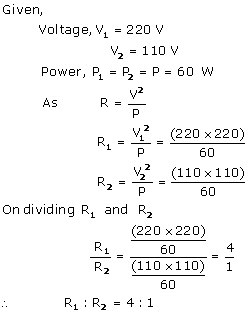
Question 13
An electric bulb is rated 250 W, 230 V. Calculate :
(i) the energy consumed in one hour, and
(ii) the time in which the bulb will consume 1.0 kWh energy when connected to 230 V mains?
Answer 13

Question 14 (Exe-8B and 8C Current Electricity ICSE )
Three heaters each rated 250 W, 100 V are connected in parallel to a 100 V supply. Calculate:
(i)The total current taken from the supply,
(ii)The resistance of each heater, and
(iii)The energy supplied in kWh to the three heaters in 5 hours.
Answer 14

Question 15
A bulb is connected to a battery of p.d. 4 V and internal resistance ![]() . A steady current of 0.5 A flows through the circuit. Calculate:
. A steady current of 0.5 A flows through the circuit. Calculate:
(i)The total energy supplied by the battery in 10 minutes,
(ii)The resistance of the bulb, and
(iii)The energy dissipated in the bulb in 10 minutes.
Answer 15
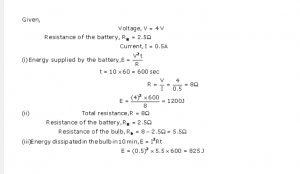
Question 16
Two resistors A and B of 4 ohm and 6 ohm respectively are connected in parallel. The combination is connected across a 6 volt battery of negligible resistance. Calculate: (i) the power supplied by the battery, (ii) the power dissipated in each resistor.
Answer 16


Question 17 (Exe-8B and 8C Current Electricity ICSE )
A battery of e.m.f. 15 V and internal resistance![]() is connected to two resistors of 4 ohm and 6 ohm joined (a) in series. Find in each case the electrical energy spent per minute in 6 ohm resistor.
is connected to two resistors of 4 ohm and 6 ohm joined (a) in series. Find in each case the electrical energy spent per minute in 6 ohm resistor.
Answer 17
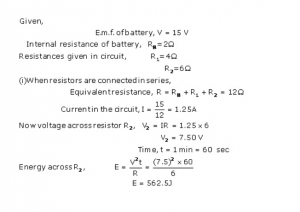
Question 18
Water in an electric kettle connected to a 220 V supply took 5 minutes to reach its boiling point. How long would it have taken if the supply had been of 200 V?
Answer 18

Question 19
An electric toaster draws 8 A current in a 220 V circuit. It is used for 2 h. Find the cost of operating the toaster if the cost of electrical energy is Rs. 4.50 per kWh.
Answer 19

Question 20
An electric iron is rated 220V, 2kW.
If the iron is used for 3h daily find the cost of running it for one week if it costs Rs 4.25 per kwh.
Answer 20
For one day energy used will be
Energy =Power x time
Energy=2 x 3=6kwh
Energy used in one week
6 x 7=42kwH
Total cost= 42x 4.25=178.5
Rs 178.5
Question 21 (Exe-8B and 8C Current Electricity ICSE )
A geyser is rated 1500 W, 250 V. This geyser is connected to 250 V mains. Calculate:
(i)The current drawn,
(ii)The energy consumed in 50 hours, and
(iii)The cost of energy consumed at Rs 4.20 per kWh.
Answer 21
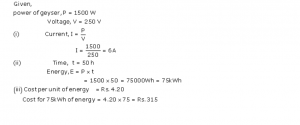
Return to Concise Selina ICSE Physics Class-10
Thanks
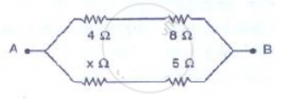
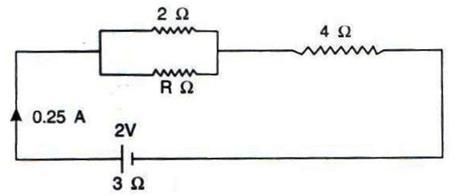

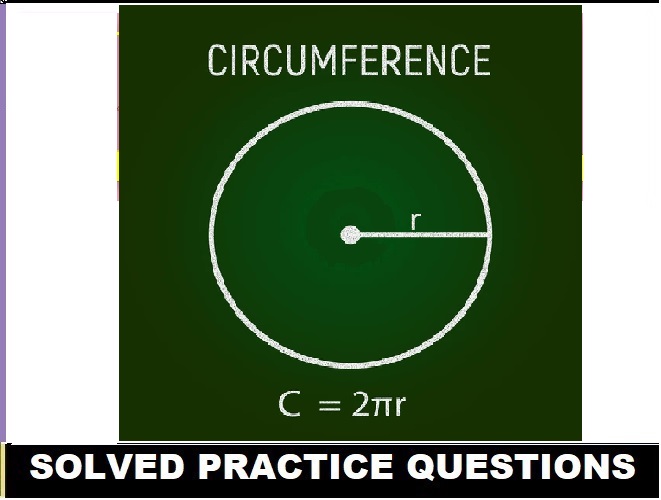
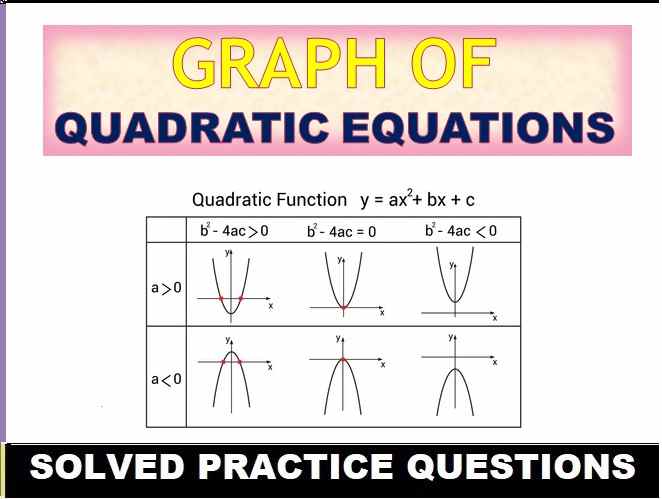
You are providing great help thanku
be prepare with strong will power . best of luck for sem-2